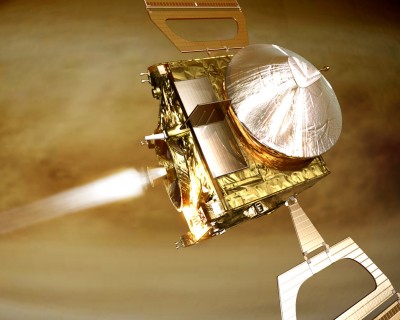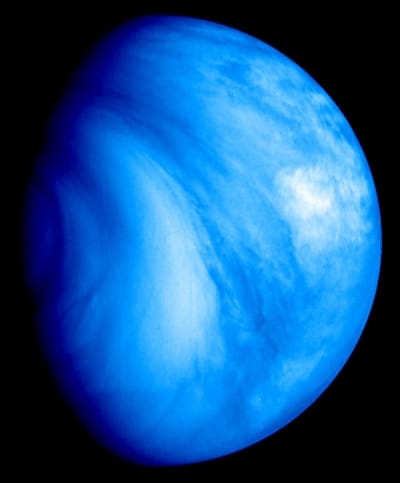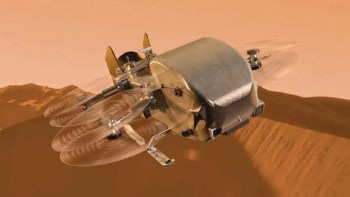
The first results from ESA’s Venus Express give weight to the popular theory that our planetary twin once had a similar climate to Earth’s, only for it to evolve into the hell-like place it is today. Among the results is proof that Venus has been steadily losing water as the result of a runaway greenhouse effect, and the first concrete piece of evidence that the planet is home to bursts of high-altitude lightning.
Formed at roughly the same time, orbiting closer than any two Solar System planets and possessing the same radius to within 5%, it is hardly surprising that Earth and Venus are often referred to as twins. But Venus’s barren surface coupled with temperatures reaching 450°C — higher even than Mercury — makes its present climate a far cry from cool, wet Earth.
Just under two years ago, ESA launched the Venus Express probe to survey the planet’s atmosphere. The reason was to see if, as scientists’ models suggest, Earth and Venus shared similar climates as young siblings and then evolved along diverse routes. Now, after the first year of analyses since the probe arrived at Venus in April 2006, scientists are confident that these models are correct.
Losing water
Although the sunlight at Venus is twice as intense as it is at Earth, its pervasive clouds of sulphuric acid reflect most of it away. The models of Venus’s evolution predict that the planet’s heat can only be a result of the huge amounts of atmospheric carbon dioxide — which, unlike on Earth, did not dissolve into water and then precipitate into limestone. This caused a “runaway” version of the greenhouse effect, increasing the temperature until all of the oceans had boiled off. Sunlight then split the resulting water vapour into its constituents oxygen and hydrogen.
On the one hand we have a freezing Mars and the other a boiling Venus — how lucky we are to be in a habitable zone
In the late 1970s, NASA’s Pioneer mission found only trace amounts of hydrogen compared with the heavier deuterium isotope, hinting that much hydrogen had managed to escape into space and therefore that the runaway greenhouse effect was a good model. Now, a group led by Jean-Loup Bertaux at the University of Pierre and Marie Curie in France has analyzed spectrometer data from Venus Express to confirm the high hydrogen-to-deuterium ratio (Nature 450 646).
Fred Taylor, another Venus Express scientist, told physicsworld.com that although Earth does not have anywhere near the levels of carbon dioxide as Venus, the greenhouse-effect mechanism is essentially the same. “Earth is moving along the curve that connects it to Venus,” he said. “Of course, it will be all over for humanity long before we get there!”
In another study, Stas Barabash at the Swedish institute of Space Physics and colleagues give another reason why Venus is so dry. They have taken data from Venus Express’s plasma analyser to show that the Sun’s magnetic field is dragging hydrogen and oxygen ions away from Venus in almost precisely the 2:1 ratio they are found in water (Nature 450 650).
Stormy weather
The results from Venus Express have also resolved controversy over whether, like Earth, the planet experiences lightning storms. A group led by Christopher Russell from the University of California in Los Angeles, US, having analyzed data from the probe’s magnetometer, discovered that the region around Venus’s north pole produces brief, low-frequency electromagnetic waves or “whistlers” — proof of an electrical discharge (Nature 450 661).
“The clouds on Venus are about 50 km above the surface and the atmosphere is thick, so it is very unlikely to have cloud-to-ground lightning,” Russell told physicsworld.com. “Thus I would expect most lightning strikes would go from the cloud deck to the ionosphere. This path is relatively rare on earth.”
Speaking at the ESA results conference today, Dmitry Titov, science coordinator of the Venus Express mission, concluded by highlighting the differences between the terrestrial planets. “On the one hand we have a freezing Mars and the other a boiling Venus,” he said. “How lucky we are to be in a habitable zone…We cannot yet answer the question [of why Earth and Venus’s atmospheres are presently dissimilar], but Venus Express is bringing us closer than ever before.”




